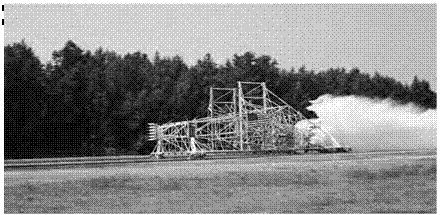Slip, Sliding Away
Before an aircraft can get into the winter sky and safely avoid the threat of icing, it first must take off from what the pilot hopes is a long, wide, dry runway at the beginning of the flight, as well as at the end of the flight. Likewise, NASA’s contributions to air safety in fighting the tyranny of temperature included research into ground operations. While NASA did not invent the plow to push snow off the runway, or flamethrowers to melt off any stubborn runway snow or ice, the Agency has been active in studying the benefits of runway grooves since the first civil runway was introduced in the United States at Washington National Airport in December 1965.[1260]
Runway grooves are intended to quickly channel water away from the landing strip without pooling on the surface so as to prevent
 |
|
hydroplaning. The 3-mile-long runway at the Shuttle Landing Facility is probably the most famous runway in the Nation and known for being grooved. Of course, there is little chance of snow or ice accumulating on the Central Florida runway, so when NASA tests runway surfaces for cold weather conditions it turns to the Langley Aircraft Landing Dynamics Facility at NASA’s Langley Research Center (LaRC) in Hampton, VA. The facility uses pressurized water to drive a landing-gear-equipped platform down a simulated runway strip, while cameras and sensors keep an eye on tire pressure, tire temperature, and runway friction. Another runway at NASA’s Wallops Flight Facility also has been used to test various surface configurations. During the mid-1980s, tests were performed on 12 different concrete and asphalt runways, grooved and non-grooved, including dry; wet; and snow, slush, and ice-covered surface conditions. More than 200 test runs were made with two transport aircraft, and more than 1,100 runs were made with different ground test vehicles. Ground vehicle and B-737 aircraft friction tests were conducted on grooved and nongrooved surfaces under wet conditions. As expected, grooved runway surfaces had significantly greater friction properties than non-grooved surfaces, particularly at higher speeds.[1261]










